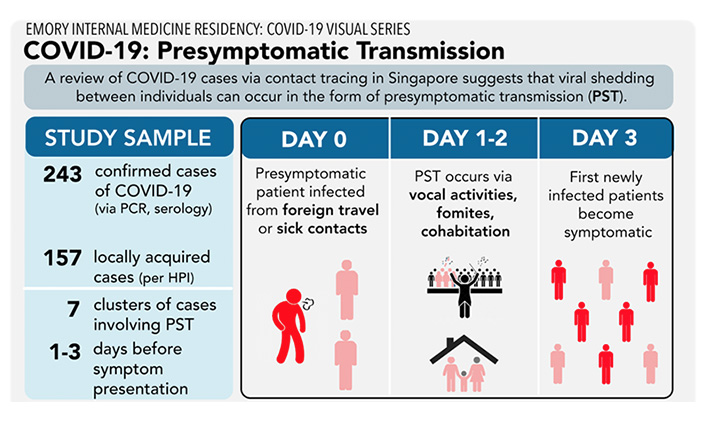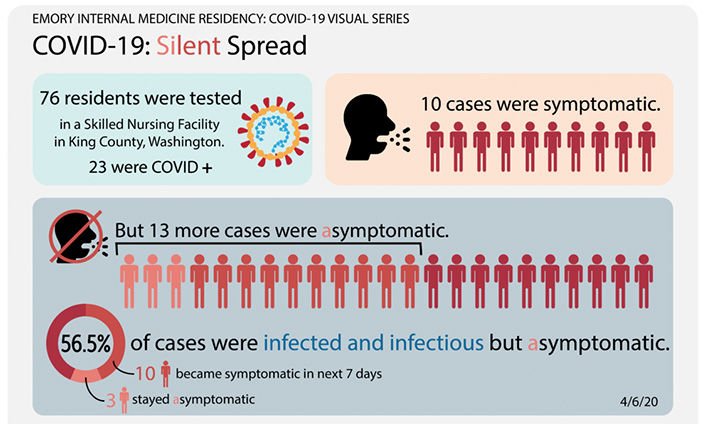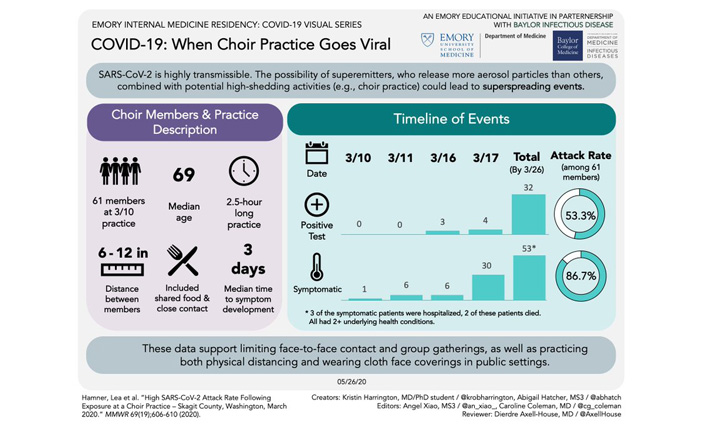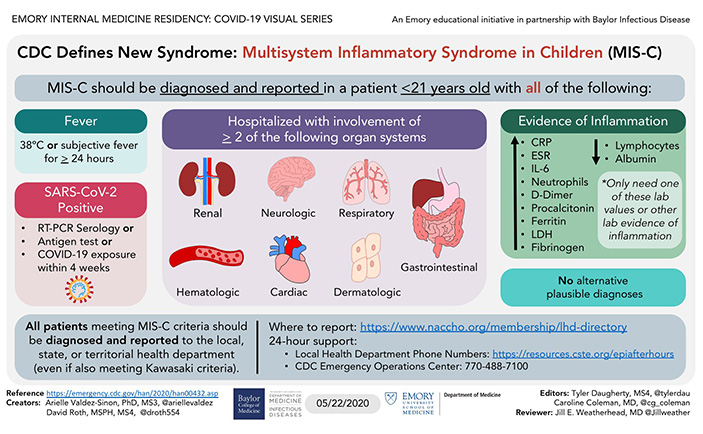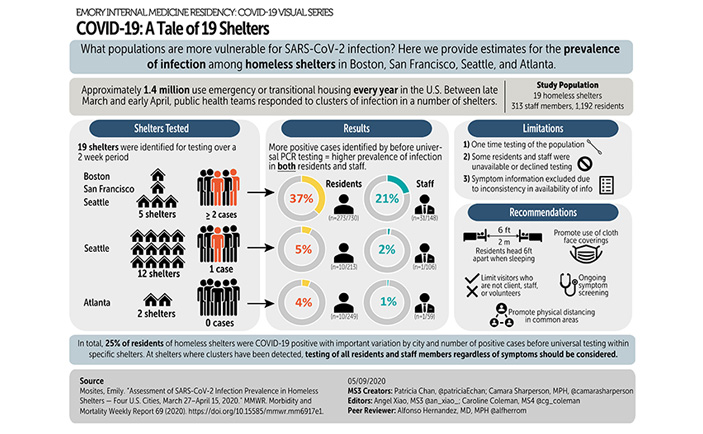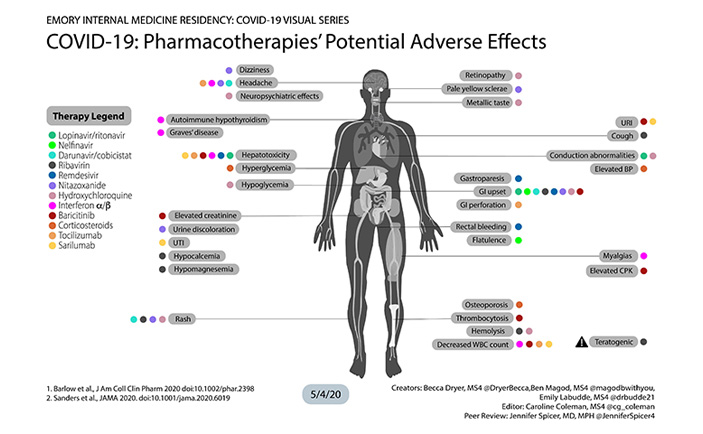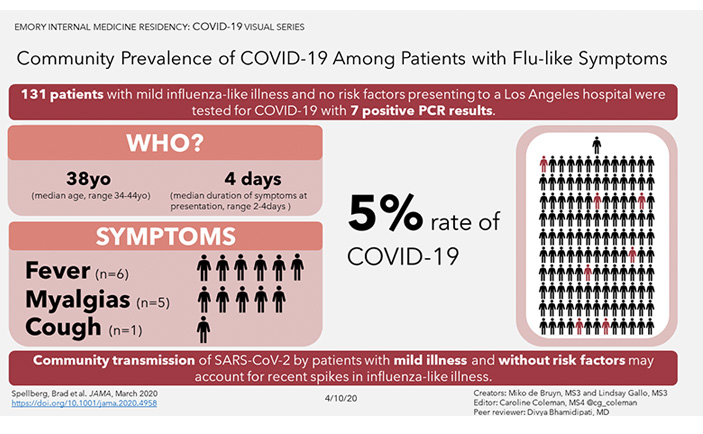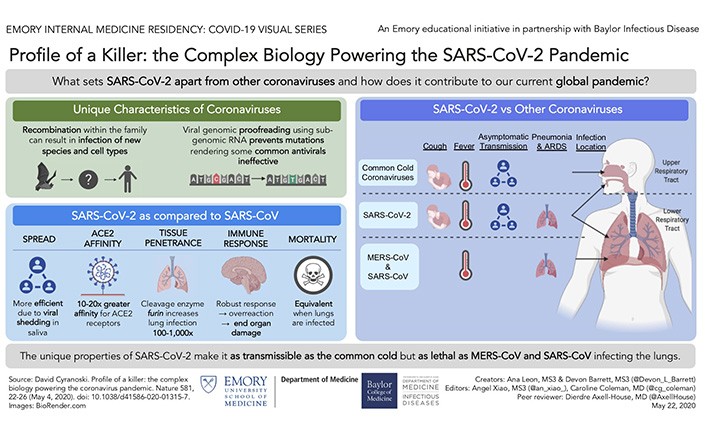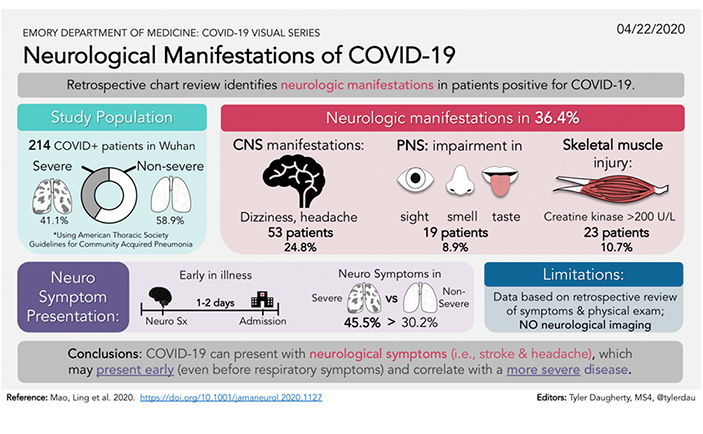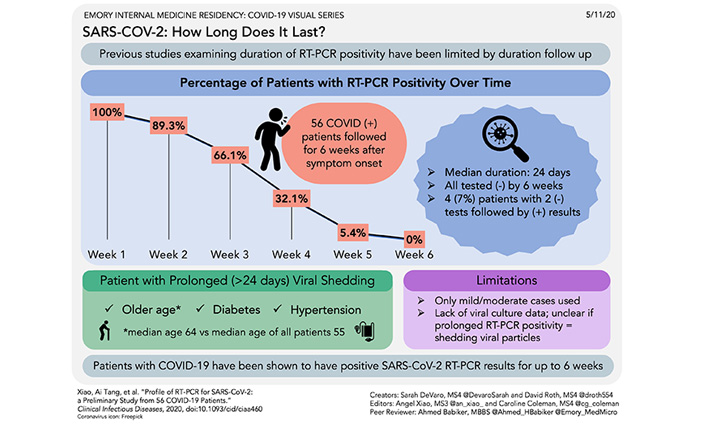Caroline Coleman, a fourth-year medical student at Emory, was only two months from graduation when everything changed. Just a week into a course that included visits to the cardiology unit at Grady Memorial Hospital, she and her classmates were informed that all student clinical work was being canceled. It was March 2020 and with the growing COVID-19 pandemic, the American Association of Medical Colleges had advised that students not take part in any direct patient care.
Coleman was wondering what exactly she'd be doing for the rest of her final semester when, out of the blue, she received an email from Karen Law, MD, program director of the Department of Medicine's internal medicine residency program. "The residents are overworked, the physicians are overworked, everyone's overworked," wrote Law. "I know that you have some free time. Would you be interested in helping summarize some of the COVID-related literature so that our residents can stay up to date?"
With an interest in medical education as well as illustration, and wanting to help with the battle against COVID-19, Coleman agreed to join on.
Providing essential tools to the front line
The project, which became known as the "COVID-19 Visual Series," involves gathering the latest medical and scientific research on COVID-19, focusing in on the highest quality and most relevant work, and translating it into accurate, easy-to-read infographics, which they call "visual abstracts."
For example, in early May the Centers for Disease Control and Prevention (CDC) issued a report on the prevalence of the virus in homeless shelters. Testing showed that at the shelters studied, 25% of shelter residents were COVID-19 positive. The dense statistical language of the paper, along with a table of data, was translated into a one-page visual abstract illustrating key findings, noting limitations of the study, and making recommendations on slowing the spread. Finally, the team shared the final product on both Instagram and Twitter, just as they do with all infographics.
"It's been exciting," says Law. "It's all about trying to have these visuals available so that residents or faculty will have ready access to the latest scientific findings, pre-processed, so they can actually keep up when they're so busy right now."
COVID-19 is an entirely new disease, so often residents have no prior experience. But with visual abstracts readily accessible on social media, physicians needing specific information can quickly scroll through and find relevant resources, boiled down to the essentials.
A full-scale operation
As the pandemic escalated, what had begun as an experiment to aid busy medical residents evolved in an online publishing operation involving over 100 Emory medical students, a large group of infectious disease fellows, and several professors, primarily Law and Jennifer Spicer, MD, who serve as faculty advisers.
Coleman, who received her MD in May, became the editor-in-chief by default, and is assisted by three editors.
The process begins with infectious disease fellows. "They'll identify the hot articles of the week and then do a quick summary of the methods, key findings, limitations," Coleman explains.
Once Coleman and the team receive the list of new articles, they transfer them to a Google spreadsheet, with each paper listed along with sign-up slots for students, who form two-person teams. The slots tend to fill up very quickly.
While at times students deliberately sign up for an assignment together, most often the teams are formed either randomly or due to a common interest in the research paper's subject.
"One of the neatest parts was that work is a lot of time between different classes," says Coleman. "So for example a second-year and a fourth-year will work together."
Whether the authors know one another or not, they must do all their work virtually, due to social distancing. As a case in point, Coleman says she's never met her three editors in person.
Once students form teams, they are given the summary and link for their article along with a three-day deadline. Students read the summary put together by the fellows and then the paper itself. These are usually densely worded documents full of statistics, highly technical language, footnotes, academic citations and data tables.
This immersion in the nitty-gritty is exactly the type of learning medical faculty like Law want to see. "Their work in the primary literature has felt so much more meaningful than any of the other ways that we tried to get them involved with research," she says.
Once they've gotten a handle on the findings of the paper, the student teams synthesize their understanding into a visual abstract using software like Adobe Illustrator and Microsoft PowerPoint. Coleman has crafted a visual style that adheres to a set color palette, rules for fonts and best practices.
Next, the visual abstract proceeds to one of the three assistant editors. They exchange edits, much like a reporter and a newspaper editor, until a draft is ready to be sent on to Coleman. She then works with the student team until the infographic is completed. Finally the visual abstract is sent over to the final reviewer, usually is the same person who created the original summary. Their role is to make sure that it's all been conveyed accurately.
Once the final reviewer gives it the thumbs up, the completed infographic is posted to social media. Law posts them to her Instagram account and Spicer to her Twitter account. On Twitter, the slides are posted along with links to the source material.
As of early June, the project had produced 137 visual abstracts, many of which are available on the Department of Medicine's web site.
Social media as a starting point
By using social media as the distribution method, not only do the visual abstracts get seen and spread through shares, but they become the topic of conversation. At times, the back and forth on Twitter resembles a real-time peer review of a sort, says Spicer.
"We've had a lot of experts come in and comment on interpretations," she says. It's not only experts within infectious disease medicine who respond, but non-clinical researchers like biologists and chemists who are providing feedback based on their expertise.
Seeing this sort of discourse on social media is a new experience for most students. In fact, Spicer notes, when the project began, few of them were on Twitter.
Editor-in-chief Coleman was one of the students who had never used social media in a professional sense. "I was on Instagram for just personal life stuff, which is mostly pictures of my dog," she says. "And I wasn't on Twitter. So with this project, I was able to have a more professional slant to my Instagram and also tap into what people call 'med Twitter.'"
Using Twitter has also initiated a lot of connections, like virtual introductions to professors and other experts outside Emory. "And we can make these connections a lot quicker than publishing a paper," Coleman says. "It's a really exciting way to collaborate."
Spicer uses her own Twitter account for posting, for several reasons. In the beginning, it was because she had an established network of people in her field, including infectious disease specialists, microbiologists, and immunologists. Another factor in the choice was legitimacy; as an infectious disease doctor, she had the credibility that a student or student-run account would not. Finally, the account needed firm moderation.
The future
Based on their experiences, Coleman, Law and Spicer say they're sure that the project will continue to expand, transforming student learning far beyond the Department of Medicine and COVID-19.
It's already begun, says Coleman. "We have created graphics for the ICU providers that make their guidelines into something that's pocket-sized, laminated and a reference. It's easier to look at than a five-page PDF."
Project leaders say there are "spin-offs" in the works in other school departments and residency programs. Rather than focusing on COVID-19, students will work on translating the work of the specialty area, whether it's cardiology, psychiatry, or something else.
As educators, Law and Spicer are interested in using what they've discovered about learning and teaching. Law says she plans to send surveys to the students who participated in the project and find out how or if it helped to increase their comfort level with engaging with the primary literature. Spicer has ideas about transforming the medical research poster, a mainstay of scientific meetings.
Meanwhile, since graduating in May, Coleman is readying herself for her medical residency. She's staying with Emory, with a residency in internal medicine.
It's been a strange time to be a student, she says. "It changes everything — how learning happens, our big event, how we're going to practice medicine."
But Coleman is excited about moving on to that next phase. "As someone that's entering residency, it's really exciting to finally be like, 'I've made it. I can finally start helping people in a direct way instead of in this sort of indirect way.'"

